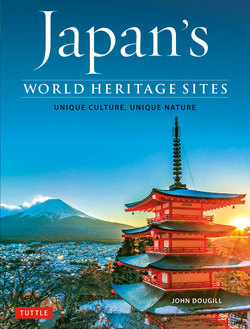Читать книгу Japan's World Heritage Sites - John Dougill - Страница 17
На сайте Литреса книга снята с продажи.
ОглавлениеGINKAKU-JI
THE SERENE TEMPLE OF THE SILVER PAVILION
GINGAKU-JI AT A GLANCE
FEATURES A Rinzai Zen temple (formal name Jisho-ji) with Silver Pavilion, Hondo (Main Hall), Togudo Hall, dry landscape garden and pond garden.
ACCESS From Kyoto JR stn, bus no. 5, 17 or 100 to Ginkaku-ji mae (40 mins) or 10 mins by taxi from Shimogamo Shrine. Alternatively, walk along Philosopher’s Walk from Nanzen-ji (30–40 mins).
PRACTICALITIES 8.30–17.00 (9.00–16.30 Dec–Feb). ¥500. Temple tel. (075) 771-5725. Allow about 1 hour to visit.
DATELINE
1460—Work begins on an estate
1480—Work resumes after Onin War
1490—Conversion to Zen temple
The Silver Pavilion stands in Kyoto’s northeast and was built by the grandson of the founder of the Golden Pavilion in the northwest. Erected almost a century later, it was intended to be a counterpart to its more famous predecessor. Both pavilions were originally part of large retirement estates. Both were converted to Zen temples following the death of the founder, and both were associated with artistic movements. But whereas one glistens with gold leaf, the other is strangely silver-less. Some think it all the finer for being so.
Unlike his grandfather, Ashikaga Yoshimasa (1436–90) did not distinguish himself as shogun, for the arts were more to his taste than politics. While the country crumbled around him, giving rise to the Onin War (1467–77) which destroyed most of Kyoto, Yoshimasa made plans for his retirement. The enormous estate he created (30 times its present size) contained a dozen pavilions for leisure pursuits such as moon viewing and flower arrangement. The Higashi-yama (Eastern Hills) Culture that developed produced excellence in a number of fields, including poetry, garden design, architecture and the tea ceremony.
Of Yoshimasa’s original estate, only two buildings have survived: the Silver Pavilion and the Togudo Hall. Like its predecessor, the two-storey pavilion mixes different styles in its architecture, with the residential style of the first floor set against the Zen style of the second. The roof is covered with overlapping shingles made of Japanese cypress, each of which is fixed in place with a bamboo nail. The route through the garden is designed so that after an initial glimpse of the pavilion, visitors are steered to a distant view from a hillside before being shown the building close up.
It is said that Yoshimasa’s plan to add silver foil to the building was never implemented for lack of funds, but there may have been another factor. The retired shogun was an admirer of the poetic and spiritual qualities of the moon, which rose from behind the ‘Moon Awaiting Hill’ to spill its light on the lacquered exterior of the pavilion. The silvery light would have been intensified by the light reflected from the pond before it, and perhaps Yoshimasa decided this was sufficient. Ironically, given its name, the bare wood building is now hailed as an example of restraint and rustic sensibility.
